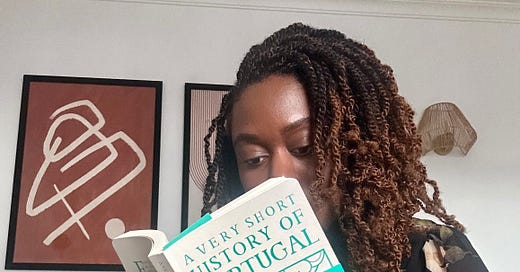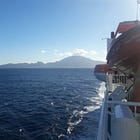🎧Listen: how I met my doppelgänger and discovered the ship that changed the world
Episode #5 of Beyond Hyphenation: A Deep History of Diasporas
The Nigerian diaspora is one of the largest in the world, so I wasn’t surprised when a friend claimed to have just met a Nigerian in Italy who looked just like me. This was about a decade ago. My friend is an Italian born to Ugandan parents and is pretty well connected in the African immigrant community in Italy.
He placed me and the person I supposedly look like in a Facebook messenger group chat. When I clicked on her profile, I immediately saw the resemblance. We had similar eyes, the exact same complexion, and even the same hairstyle at the time.
As we continued chatting, I found out she was also Yoruba, born to Nigerian parents living in the diaspora. We had similar mannerisms and ways of seeing things. Our personalities were aligned like two cars going in the same direction at the same speed.
We look alike and talk alike which if that wasn’t already weird enough, I got a Facebook notification. It was her birthday! A rock suddenly appeared in my stomach because it was my birthday too. How could this be?
We were born on the exact same day, in the same year, with the same ethnicity, with similar personalities and we were complete strangers when we met. I think I’ve met my doppelgänger.
What are the chances of meeting your doppelgänger? Apparently, the chances of this happening are extremely unlikely. With more than 7 billion people on earth, there’s about a 1 in 134 chance of there even being a doppelgänger alive at the same time.1
It was very weird seeing myself as myself, chatting with someone so similar to me. Just the mere idea that there’s someone like me living a parallel life to me is a hard reality to grasp. This was about a decade ago and I no longer have a Facebook, so I’m unable to see what my doppelgänger is up to. Maybe we’ll meet again. Maybe not.
(p.s. if any of you ever see someone who looks like me in your city, please respond to this email ASAP lol)
I was thinking of my doppelgänger after I saw a 15th-century ship docked on the shores of Lagos, Portugal. As I got closer, I noticed it was pretty intact for a ship that looked so old.
“It’s a replica. A duplicate.” This is what my tour guide told me as my furrowed brows began to relax.
The name of the ship is Boa Esperança and in 1488 the original ship was used by Bartolomé Diaz to create a European route to Asia by sailing around the African continent for the first time. Before then, there was no reliable sea route that a European had taken to reach the Indian Ocean.
Boa Esperança means “Good Hope,” a name meant to embody the Portuguese empire’s hopes that such an expedition would expand the empire’s trading monopoly into new territories. However, reaching the southernmost tip of the African continent was not an easy journey. When Diaz and his men began to approach the western coast of what is today South Africa, the seas became untamable and storms began to rage.
At this point, Portuguese ships or caravels were fitted with the best seafaring technology available at the time. The Portuguese historian, A.H. de Oliveira Marques, puts it like this:
“The discovery of the Atlantic Ocean, particularly after the passage of the equator, posed a certain number of problems, all difficult to solve. The wind system south of the equator followed a symmetrical pattern to the one north of it, something the Portuguese realized around the 1480s, if not before. Such a discovery enabled them to prepare carefully the best route to and from Asia. Once in the Indian Ocean, the way to and from India was determined by the monsoon system. This enabled the Portuguese to time the arrival and departure of their fleets according to a very regular schedule.”2
He goes on to show that the Portuguese created handbooks to prepare future captains to navigate the different wind and sea patterns south of the equator. He continues:
“Late in the 1400s, the Portuguese also developed navigation guides (roteiros), where the coastline and its adjacent waters were carefully described. Roteiras were used along with the so-called livros de marinharia («sailing books»), a type of handbook containing everything that a pilot should know.”3
Despite the heavy storms and unpredictable weather, Diaz and his men eventually saw the shores of the southernmost tip of the African continent in February of 1488. When I saw the exact date, I took a closer look. Suddenly, I felt that eerie, weird feeling again.
This couldn’t be.
What are the chances?
The exact date Diaz saw what is now the Cape of Good Hope is my birthdate.
This date that marks the dawn of new European imperialism and colonialization in the eastern hemisphere happened on my birthday centuries ago. As a historian, perhaps I shouldn’t be too surprised. There are only so many days in a year. However, something about this still feels uncanny, yet aligned. Almost, like I was meant to find this out and tell this story.
The ship that now sits on the shores of Lagos is just a replica. Yet, walking around it, I still have the same feeling I had when I met my doppelgänger all those years ago. I am staring through a window into the past, but also a mirror. The ship, although just a copy, was meant to serve as a monument to Portugal’s nautical supremacy in the 15th century.
I did some searching and it looks like the ship served as an “interpretation center” (they purposefully avoided the use of the word museum here) where tourists could explore the history of Portuguese ships during the 15th-century age of discovery. However, when I saw the ship recently, it just sat there fixed in time on the shores of Lagos. It was no longer accessible to the public. It’s currently unclear why this is the case today.
The official narrative seems to be that 1488 was Portugal's contribution to world history as Portuguese explorers such as Dias, were the first to circumvent the world via the south of Africa. However, Portugal's contributions to world history are much deeper than that. Portugal didn’t just open up the world to new forms of navigation and discovery. Lagos, on the shores where I stand, was the first port of entry for enslaved Africans outside of Africa.
As I’m writing this, AfroNation is taking place here in Portugal in a city called Portimao, just a couple of kilometers from Lagos. Nearly 40,000 people are gathering for this music festival to listen to artists from across the African diaspora. Amapiano and Afrobeats are filling the air. There is joy, love, music, dancing, and culture beaming to the brim in this coastal city.
Yet, here I am shaken to my core at the pure idea that just a few centuries ago people like me were shipped to these shores as slaves. The transatlantic slave trade began here. The African diaspora began here. Can a new narrative also begin here too?
Perhaps, it’s only fitting that Africans are reclaiming what was once a land of unspeakable horror and transforming it into a land of enjoyment, even if just for a weekend.
There’s so much more to explore and we’re only at the tip of it all!
We dig deeper next week,
🌊Catch up on past episodes of Beyond Hyphenation: A Deep History of Diasporas here:
A.H. De Oliveira Marques, A Very Short History of Portugal, 86-87.
Ibid.








